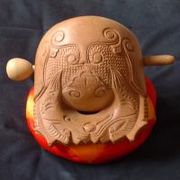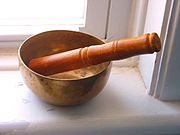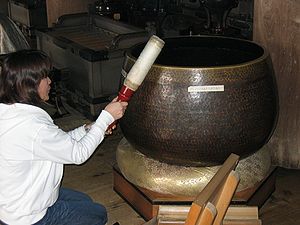
Telemusik
Encyclopedia

Electronic music
Electronic music is music that employs electronic musical instruments and electronic music technology in its production. In general a distinction can be made between sound produced using electromechanical means and that produced using electronic technology. Examples of electromechanical sound...
by Karlheinz Stockhausen
Karlheinz Stockhausen
Karlheinz Stockhausen was a German composer, widely acknowledged by critics as one of the most important but also controversial composers of the 20th and early 21st centuries. Another critic calls him "one of the great visionaries of 20th-century music"...
, and is number 20 in his catalog of works.
History
Through his composition student, Makoto ShinoharaMakoto Shinohara
is a Japanese composer.- Biography :Shinohara studied at the Tokyo University of the Arts from 1952 to 1954, studying composition with Tomojiro Ikenouchi, piano with Kazuko Yasukawa, and conducting with Akeo Watanabe and Kurt Woess. From 1954 to 1960, he studied in Paris with Tony Aubin, Olivier...
, Stockhausen was invited by the Japan Broadcasting Corporation NHK
NHK
NHK is Japan's national public broadcasting organization. NHK, which has always identified itself to its audiences by the English pronunciation of its initials, is a publicly owned corporation funded by viewers' payments of a television license fee....
to visit Tokyo, and to carry out two commissions in their electronic music studio, in connection with the 50th anniversary of the founding of NHK in 1965. Because of other commitments, Stockhausen was unable to meet this schedule but finally, under pressure from Tokyo, he flew to Japan on 19 January 1966 (Kurtz 1992, 141). According to a note in the score,
Telemusik was realized between January 23 and March 2, 1966 in the Studio for Electronic Music of the Japanese broadcasting system Nippon Hoso Kyokai (NHK), in collaboration with the director of the studio, Wataru Uenami and the studio technicians Hiroshi Shiotani, Shigeru Satô and Akira Honma. (Stockhausen 1969)The score is dedicated to the Japanese People. The first public performance took place at the NHK studios in Tokyo on 25 April 1966, in a program which also featured the first and second performances (in versions for trombone and for flute) of Stockhausen's other NHK commission, Solo (Kurtz 1992, 144).
Materials and concepts
The substance of the work consists of recordings of a variety of traditional ethnic musics from around the world, together with electronically generated sounds (Stockhausen 1971b, 79). More than twenty of these recorded fragments are intermodulated on tape with electronic sounds and with each other to produce "odd hybrid-types"—modulating, for example, "the chant of monks in a Japanese temple with ShipiboShipibo-Conibo
-Population:The name refers to two languages spoken by these ethnic groups. They are primarily a riverine people living in the Amazon basin, primarily along the Ucayali River. Contact with western sources – including the governments of Peru and Brazil – has been sporadic over the past three...
music from the Amazon, and then further impos[ing] a rhythm of Hungarian music on the melody of the monks. In this way, symbiotic things can be generated, which have never before been heard" (Stockhausen 1996, 94). Only seven of the work's thirty-two moments—nos. 1, 2, 4, 6, 8, 10, and 16—are restricted entirely to electronic sounds (Kohl 2002, 97). The pitch range is deliberately kept rather high, between 6 and 12 KHz, so that the intermodulation can occasionally project sounds downwards, sections "that seem to be so far away because the ear cannot analyse it, so that it entered the normal audible range and suddenly became understandable". In this way, register becomes a means of bringing the “distant” close up (Greek tele, "afar, far off", as in "telephone" or "television") the concept from which the title of the work is derived (Stockhausen 1966).
The work was created using a six-track tape recorder custom-built for the NHK studios. One track was reserved for editing during production, with the completed music being intended for playback in five channels, arranged in a circle around the audience. However, there are none of the continually-moving-sound techniques found in other of Stockhausen's electronic works, such as Kontakte, Sirius
Sirius (Stockhausen)
Sirius: eight-channel electronic music and trumpet, soprano, bass clarinet, and bass is a music-theatre composition by Karlheinz Stockhausen.-History:...
, or Oktophonie from Dienstag aus Licht. The spatial conception of Telemusik is therefore closer to that of Gesang der Jünglinge
Gesang der Jünglinge
Gesang der Jünglinge is a noted electronic music work by Karlheinz Stockhausen. It was realized in 1955–56 at the Westdeutscher Rundfunk studio in Cologne and is Work Number 8 in the composer's catalog of works...
, which was also originally in five channels. For performances elsewhere than at the NHK studios, Stockhausen mixed down several two-channel stereo copies, using a panorama console to approximately position the five channels from left to right as I IV III II V (Kohl 2002, 112–13).
Form


Singing bowl
Singing bowls are a type of bell, specifically classified as a standing bell. Rather than hanging inverted or attached to a handle, singing bowls sit with the bottom surface resting...
and keisu, ending with a group of four large temple bells for the longest of the six durations used (Kohl 2002, 102). The durations in seconds of these moments are taken from the six Fibonacci number
Fibonacci number
In mathematics, the Fibonacci numbers are the numbers in the following integer sequence:0,\;1,\;1,\;2,\;3,\;5,\;8,\;13,\;21,\;34,\;55,\;89,\;144,\; \ldots\; ....
s between 13 and 144. The numbers of occurrences of these steps are also drawn from Fibonacci numbers, from 1 to 13 (Erbe 2004, 132; Kohl 2002, 100). The longer the step, the fewer times it occurs, and vice versa:
However, the actual duration values used in the score are systematically varied above these base values so that from longest to shortest there are 1, 2, 3, 4, 3, and 2 variants (144, 89/91, 55/56/57, 34/35/36/37, 21/22/23, and 13/14). In order to achieve the specified numbers of moments, the variants of the shorter values are duplicated, again according to the Fibonacci series (13 × 5, 14 × 8; 21 × 3, 22 × 3, 23 × 2; 34 × 2, and the rest with single instances) (Kohl 2002, 101).
| identifying instrument | duration (secs.) | no. of occurrences | total durations (secs.) |
| temple bells | 144 | 1 | 144 |
| keisu | 89/91 | 1 + 1 = 2 | 180 |
| rin | 55/56/57 | 1 + 1 + 1 = 3 | 168 |
| mokugyo | 34/35/36/37 | 2 + 1 + 1 + 1 = 5 | 176 |
| bokushō | 21/22/23 | 3 + 3 + 2 = 8 | 175 |
| taku | 13/14 | 5 + 8 = 13 | 177 |

The moments' durations are distributed over the length of the composition as follows (Kohl 2002, 103):
| taku | bokushō | mokugyo | rin | keisu | temple bells | cumulative durations | |
|---|---|---|---|---|---|---|---|
| 1 | 21 | 21 | |||||
| 2 | 13 | 34 | |||||
| 3 | 34 | 68 | |||||
| 4 | 14 | 82 | |||||
| 5 | 22 | 104 | |||||
| 6 | 13 | 117 | |||||
| 7 | 14 | 131 | |||||
| 7 Forts. | 13 + 14 | 158 | |||||
| 8 | 55 | 213 | |||||
| 9 | 35 | 248 | |||||
| 10 | 21 | 269 | |||||
| 11 | 89 | 358 | |||||
| 12 | 13 | 371 | |||||
| 13 | 23 | 394 | |||||
| 14 | 14 | 408 | |||||
| 15 | ↕ | 37 | 445 | ||||
| 16 | ↕ 57 | ↑ | 502 | ||||
| 17 | 22 | ↓ | 524 | ||||
| 18 | 13 | ↕ | 537 | ||||
| 19 | 14 | 551 | |||||
| 20 | 23 | 574 | |||||
| 21 | 36 | 610 | |||||
| 22 | 91 | 701 | |||||
| 23 | 14 | 715 | |||||
| 24 | 56 | 771 | |||||
| 25 | 21 | 792 | |||||
| 26 | 14 | 806 | |||||
| 27 | 34 | 840 | |||||
| 28 | 14 | 854 | |||||
| 29 | 22 | 876 | |||||
| 30 | 14 | 890 | |||||
| 31 | 144 | 1034 | |||||
| 32 | 13 | 1047 |
The "extra" moment marked "7 Fortsetzung" (7 continued) is an insertion which repeats the long composite of descending glissandos from the two preceding moments, ring modulated
Ring modulation
Ring modulation is a signal-processing effect in electronics, an implementation of amplitude modulation or frequency mixing, performed by multiplying two signals, where one is typically a sine-wave or another simple waveform. It is referred to as "ring" modulation because the analog circuit of...
with a 12,000 Hz sine wave, briefly "notched" with a dip to 2,000 Hz at the point corresponding to the division between moments 6 and 7. This insert is marked at the beginning by a stroke on a Japanese temple instrument found nowhere else in Telemusik: a gong called a kane (鐘) (Kohl 2002, 104–05). Of the six resulting structural layers, or "formant rhythms" (Harvey 1975, 101) four—the second, third, fourth, and fifth—are internally symmetrical. However, their centres of symmetry, marked in the table by the symbol "↕", do not coincide, so that the composite structure is not itself symmetrical. The keisu layer is centred on the overall form, while the rin, mokugyo, and bokusho layers are phase-shifted by incrementally increasing distances to the left, right, and left again (Kohl 2002, 102).
Moments are often more or less casually grouped together into successions of two or more moments, similar to the Hauptgruppen Stockhausen conceived as early as Klavierstück I in 1952 (Kohl 2002, 110). Opinions on these groupings differ somewhat. Robin Maconie describes moments 15, 16 and 17 as a "structural episode" consisting of a sustained "resonance of consciousness", superimposing and transforming material taken from moments 1, 4, 5, 6, 7, 9, and 14 (Maconie 1976, 211–12; Maconie 2005, 267). Others variously regard as groupings:
- moments 1–3 (Fritsch 1999, 177–78; Kohl 2002, 110)
- moments 5–7 Forts., 10–11, 17–23, and 27–31 (Kohl 2002, 110)
- moments 12–14 and 24–26 (Erbe 2004, 147–48; Kohl 2002, 110)
- moments 16–21, 22–23, and 27–30 (Erbe 2004, 147–48).
Discography
- DG LP 643546 (with MixturMixturMixtur, for orchestra, 4 sine-wave generators, and 4 ring modulators, is an orchestral composition by the German composer Karlheinz Stockhausen, written in 1964, and is Nr. 16 in his catalogue of works...
, kleine Besetzung 1967, backwards version) - Stockhausen Complete Edition CD 9 (with Mikrophonie IMikrophonie (Stockhausen)Mikrophonie is the title given by Karlheinz Stockhausen to two of his compositions, written in 1964 and 1965, in which “normally inaudible vibrations . ....
and Mikrophonie IIMikrophonie (Stockhausen)Mikrophonie is the title given by Karlheinz Stockhausen to two of his compositions, written in 1964 and 1965, in which “normally inaudible vibrations . ....
) - Stockhausen Text-CD 16 (remastered November 2007)
Sources
- Cott, Jonathan. 1973. Stockhausen: Conversations with the Composer. New York: Simon and Schuster. ISBN 0671214950
- Erbe, Marcus. 2004. "Karlheinz Stockhausens Telemusik". In Kompositorische Stationen des 20. Jahrhunderts: Debussy, Webern, Messiaen, Boulez, Cage, Ligeti, Stockhausen, Höller, Bayle, ed. Christoph von Blumröder, 129–71. Signale aus Köln: Musik der Zeit 7. Münster: Lit Verlag. ISBN 3-8258-7212-2
- Frisius, Rudolf. 2008. Karlheinz Stockhausen II: Die Werke 1950–1977; Gespräch mit Karlheinz Stockhausen, "Es geht aufwärts". Mainz, London, Berlin, Madrid, New York, Paris, Prague, Tokyo, Toronto: Schott Musik International. ISBN 9783795702496
- Fritsch, JohannesJohannes FritschJohannes G. Fritsch was a German composer.At the age of seven, Fritsch found a violin in the attic of his uncle's house in Bensheim-Auerbach, Germany, and began lessons with a village music teacher named Knapp...
. 1999. "Telemusik: Fragment des Verstehens." In Internationales Stockhausen-Symposion 1998, Musikwissenschaftliches Institut der Universität zu Köln, 11. bis. 14. November 1998: Tagungsbericht, ed. Imke Misch and Christoph von Blumröder, in association with Johannes Fritsch, Dieter Gutknecht, Dietrich Kämper, and Rüdiger Schumacher, 177–85. Signale aus Köln 4. Saarbrücken: Pfau-Verlag. ISBN 3-89727-050-1. - Fuhrmann, Roderich. 1974. "Karlheinz Stockhausen: Telemusik". Musik und Bildung 6 (January): 24–29. Published at the same time in Perspektiven Neuer Musik—Material und didaktische Information, edited by Dieter Zimmerschied, 251–65. Mainz: B. Schott's Söhne. ISBN 3795729513.
- Gruber, Gernot. 1999. "Stockhausens Konzeption der 'Weltmusik' und die Zitathaftigkeit seiner Musik". In Internationales Stockhausen-Symposion 1998, Musikwissenschaftliches Institut der Universität zu Köln, 11. bis. 14. November 1998: Tagungsbericht, ed. Imke Misch and Christoph von Blumröder, in association with Johannes Fritsch, Dieter Gutknecht, Dietrich Kämper, and Rüdiger Schumacher, 103–11. Signale aus Köln 4. Saarbrücken: Pfau-Verlag. ISBN 3-89727-050-1.
- Harvey, JonathanJonathan Harvey (composer)Jonathan Harvey is a British composer. He has held teaching positions at universities and music conservatories in Europe and the USA and is frequently invited to teach in summer schools around the world.-Life:...
. 1975. The Music of Stockhausen: An Introduction. Berkeley and Los Angeles: University of California Press. ISBN 0520023110. - Kohl, Jerome. 2002. "Serial Composition, Serial Form, and Process in Karlheinz Stockhausen's Telemusik." In Electroacoustic Music: Analytical Perspectives, ed. Thomas Licata, 91–118. Westport, Conn. and London: Greenwood Press. ISBN 0313314209
- Kurtz, Michael. 1992. Stockhausen: A Biography, translated by Richard Toop. London and Boston: Faber and Faber. ISBN 0571143237 (cloth) ISBN 0-571-17146-X (pbk)
- Maconie, Robin. 2005. Other Planets: The Music of Karlheinz Stockhausen. Lanham, Maryland, Toronto, Oxford: The Scarecrow Press, Inc. ISBN 0-8108-5356-6
- Schatt, Peter W. 1989. "Universalismus und Exotik in Karlheinz Stockhausens Telemusik". Musica 43:315–20
- Stockhausen, Karlheinz. 1966. "Telemusik: Vortrag". Radio lecture. Released on Stockhausen Text-CD 16. Kürten: Stockhausen-Verlag, 2008. English translation by Jayne Obst.
- Stockhausen, Karlheinz. 1969. Nr. 20 Telemusik (score). Vienna: Universal Edition (UE 14807)
- Stockhausen, Karlheinz. 1971a. "Telemusik (1966)" In Karlheinz Stockhausen, Texte 3, edited by Dieter Schnebel, 75–77. Cologne: Verlag M. DuMont Schauberg. ISBN 3-7701-0493 5.
- Stockhausen, Karlheinz. 1971b. "Interview über Telemusik" In Karlheinz Stockhausen, Texte 3, edited by Dieter Schnebel, 79–84. Cologne: Verlag M. DuMont Schauberg. ISBN3-7701-0493 5. Originally published in Christ und Welt, 7 June 1968.
- Stockhausen, Karlheinz. 1996. "Electroacoustic Performance Practice". Perspectives of New Music 34, no. 1 (Fall): 74–105.
- Stockhausen, Karlheinz. 2009. Kompositorische Grundlagen Neuer Musik: Sechs Seminare für die Darmstädter Ferienkurse 1970, edited by Imke Misch. Kürten: Stockhausen-Stiftung für Musik. ISBN 978-3-00-027313-1
- Toop, Richard. 1981. "Stockhausen’s Electronic Works: Sketches and Work-Sheets from 1952–1967." Interface 10:149–97.
- Utz, Christian. 2007. "Zur kompositorischen Relevanz kultureller Differenz: Historische und ästhetische Perspektiven", in Musik und Globalisierung: Zwischen kultureller Homogenisierung und kultureller Differenz—Bericht des Symposions an der Kunstuniversität Graz, 17.–18. Oktober 2006, edited by Christian Utz and Otto Kolleritsch, 29–49. Musiktheorien der Gegenwart 1. Saarbrücken: Pfau-Verlag.
External links
- Klankwereld.org - GAGAKU-CIRCUIT - a reconstruction of the Gagaku circuit for Max 5, an audio circuit widely used in Stockhausen's Telemusik.
- Klankwereld.org - GLISSANDI vom STRUKTUR 6|7 -the glissandi from structures 6 & 7 of Telemusik programmed in Max 5.

